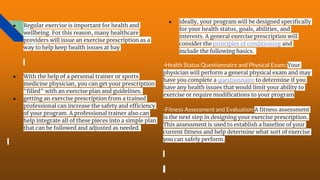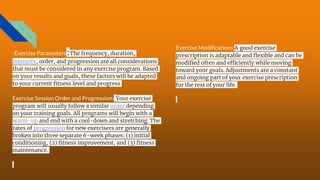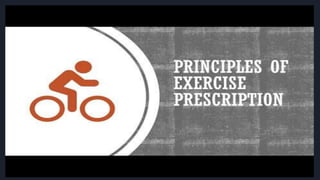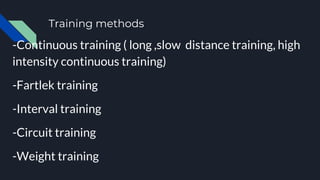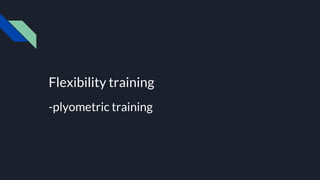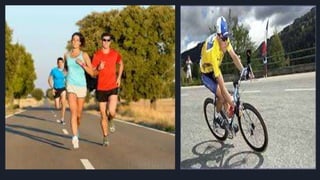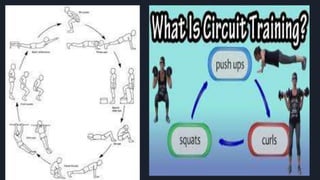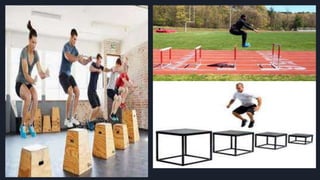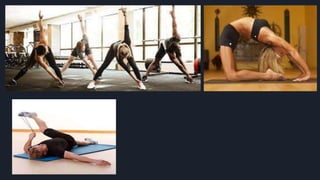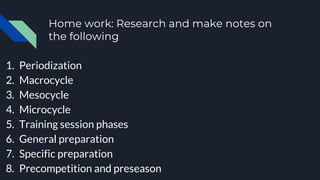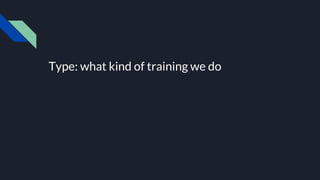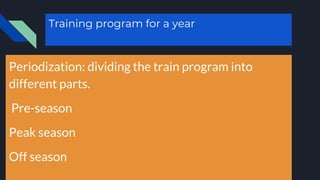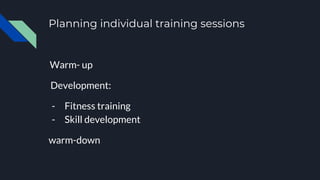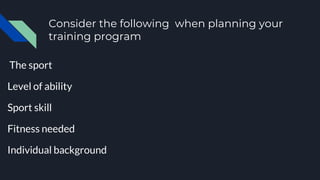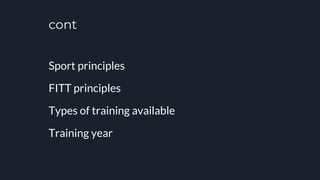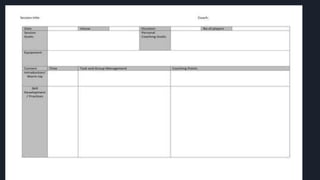_Principles of training and training methods Gr 12 now.pptx
- 2. Principles of Training and conditioning(sport Principles) Specificity Progression* Overload* Reversibility Tedium/variance
- 3. Specificity: T The type of training that you do should be specific to you and your sport
- 4. Progression* Increase training gradually. The body takes time to adapt.
- 5. Overload* Overload means we must put our bodies under more stress than normal in order for adaptive changes to be made.
- 6. Reversibility if you stop training then the improvements you have made will be reversed.
- 7. Tedium (Variance) Make training interesting. Vary the training program to avoid tedium/ boredom. This can be done by using a variety of different training methods
- 9. What is overtraining Too much training can be bad for your health. The body need rest and sleep between training sessions to facilitate recovery. Rest days are important. Symptoms and signs of overtraining are:____extreme fatigue, muscle soreness, sleep problems, loss of appetite_____________
- 10. Individual difference No two individuals have the same training needs. When designing a training program consider the following factors: â—Ź Fitness needs â—Ź Psychological needs â—Ź Maturation â—Ź Gender (male/female) â—Ź Cultural differences â—Ź age
- 11. Adaptation: The body's response is an adaptation, which refers to your body's physiological response to training. When you do new exercises or load your body in a different way, your body reacts by increasing its ability to cope with that new load.
- 12. Maintenance: The maintenance principle suggests that once an individual reaches a level of fitness that meets his or her needs, it is possible to maintain the results gained through a reduction in training frequency (up to one third); however, the intensity and duration must remain the same. The term maintenance indicates that you’re not trying to improve or increase your strength, but rather “maintain” your strength/fitness gains you’ve made.
- 13. Active involvement â—Ź Active Participation measures exactly how much time players are active vs. inactive in a session. â—Ź show how much time the players are physically moving vs. standing still.
- 14. Active involvement Giving students the opportunity to participate in individual sports gives them the best chance of incorporating physical activity through their lives, as well as improving the likelihood of them continuing in education upon leaving secondary school.
- 15. Active involvement can: Physical activity can help: â—Ź encourage social interaction. â—Ź improve concentration and learning. â—Ź increase personal confidence and self-awareness. â—Ź reduce feelings of depression and anxiety. â—Ź enhance self-esteem. â—Ź improve quality of life. â—Ź reduced risk of heart disease and stroke. reduced risk of developing high blood pressure.
- 16. Exercise prescription for performance improvement
- 17. Exercise prescription for performance improvement â—Ź Exercise prescription includes the type, intensity, duration, frequency and progression of physical activity. â—Ź These five components are applicable to the development of exercise programs for persons regardless of age, functional capacity, and presence or absence of CHD [coronary heart disease] risk factors or CHD.
- 19. â—Ź Regular exercise is important for health and wellbeing. For this reason, many healthcare providers will issue an exercise prescription as a way to help keep health issues at bay â—Ź With the help of a personal trainer or sports medicine physician, you can get your prescription "filled" with an exercise plan and guidelines. â—Ź getting an exercise prescription from a trained professional can increase the safety and efficiency of your program. A professional trainer also can help integrate all of these pieces into a simple plan that can be followed and adjusted as needed. â—Ź ideally, your program will be designed specifically for your health status, goals, abilities, and interests. A general exercise prescription will consider the principles of conditioning and include the following basics. -Health Status Questionnaire and Physical Exam::Your physician will perform a general physical exam and may have you complete a questionnaire to determine if you have any health issues that would limit your ability to exercise or require modifications to your program -Fitness Assessment and Evaluation:A fitness assessment is the next step in designing your exercise prescription. This assessment is used to establish a baseline of your current fitness and help determine what sort of exercise you can safely perform.
- 20. -Exercise Type:A big part of your exercise prescription is what exercises you will do. A good prescription will include a variety of exercises and a balanced routine to build core strength, endurance, flexibility, and base fitness first and then become much more specific to your fitness goals.
- 21. -Exercise Parameters:The frequency, duration, intensity, order, and progression are all considerations that must be considered in any exercise program. Based on your results and goals, these factors will be adapted to your current fitness level and progress Exercise Session Order and Progression: Your exercise program will usually follow a similar order depending on your training goals. All programs will begin with a warm-up and end with a cool-down and stretching. The rates of progression for new exercisers are generally broken into three separate 6-week phases: (1) initial conditioning, (2) fitness improvement, and (3) fitness maintenance. Exercise Modifications:A good exercise prescription is adaptable and flexible and can be modified often and efficiently while moving toward your goals. Adjustments are a constant and ongoing part of your exercise prescription for the rest of your life.
- 23. Training methods -Continuous training ( long ,slow distance training, high intensity continuous training) -Fartlek training -Interval training -Circuit training -Weight training
- 32. Home work: Research and make notes on the following 1. Periodization 2. Macrocycle 3. Mesocycle 4. Microcycle 5. Training session phases 6. General preparation 7. Specific preparation 8. Precompetition and preseason
- 33. cont 9. Competition phase and peak season 10.transition and off season
- 35. Frequency: how often we train
- 36. Intensity: how hard we train
- 37. Time: how long we train
- 38. Type: what kind of training we do
- 39. Training program for a year Periodization: dividing the train program into different parts. Pre-season Peak season Off season
- 40. Pre-season
- 41. Peak- season
- 42. Off- season
- 43. Planning individual training sessions Warm- up Development: - Fitness training - Skill development warm-down
- 44. Consider the following when planning your training program The sport Level of ability Sport skill Fitness needed Individual background
- 45. cont Sport principles FITT principles Types of training available Training year
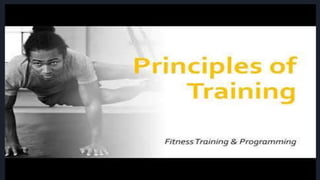


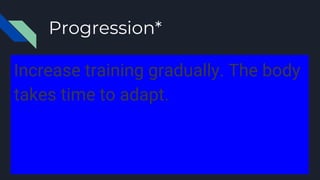
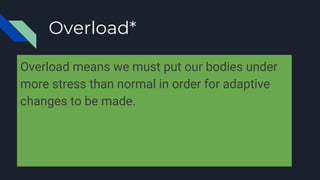
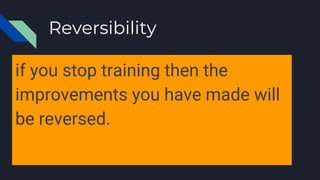
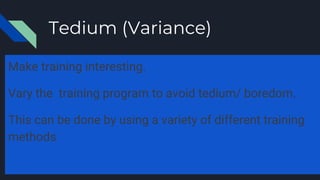
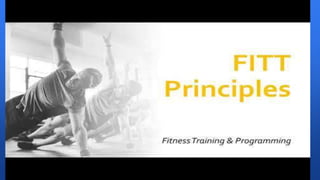
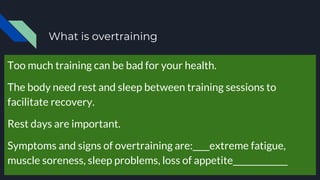
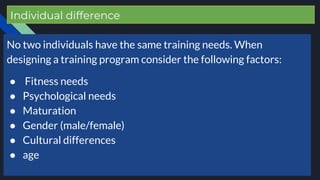
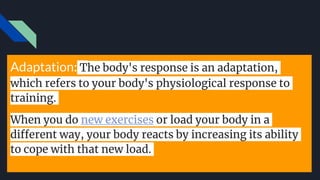
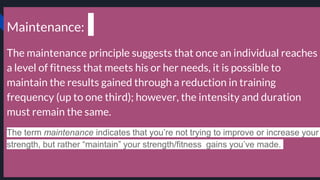
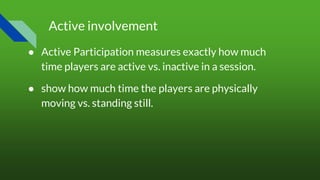
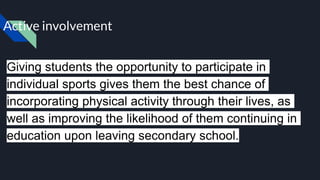
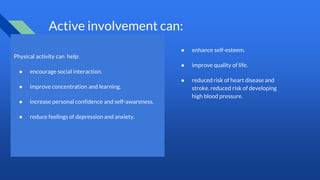
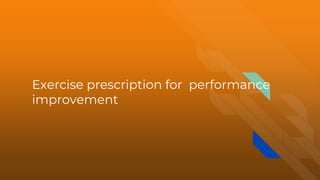
![Exercise prescription for performance
improvement
â—Ź Exercise prescription includes the type, intensity,
duration, frequency and progression of physical
activity.
â—Ź These five components are applicable to the
development of exercise programs for persons
regardless of age, functional capacity, and presence
or absence of CHD [coronary heart disease] risk
factors or CHD.](https://image.slidesharecdn.com/principlesoftrainingandtrainingmethodsgr12now-221109043534-4327b6ff/85/_Principles-of-training-and-training-methods-Gr-12-now-pptx-17-320.jpg)

